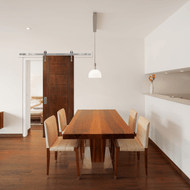A Guide to Interior Design Styles: Contemporary
Aug 16th 2018
Of all the interior design styles, contemporary is one of the more difficult to define.
Though it was born in the 1970s, contemporary literally means “in the moment.” Trends, culture and the passing of time itself means contemporary interior design is ever-evolving. In addition, contemporary borrows from and blends with design concepts including Modernism, Art Deco, Futurism and more.
So without a clear definition, how do you create a contemporary space in your home? These principles will guide you.
NEUTRAL
Today, neutral shades and black and white, are primary colors in the contemporary palette and should be prioritized in your design.
Mixing multiple neutral shades in a room is also popular. Black is often used to ground a room or frame an area of interest.
Neutral wall colors allow for bold accessories and art. Consider a stark white wall with a blocky, geometric print in a clean black frame. A monochromatic room can benefit from a tall, bright vase in the corner and accent pillows in similar bright shades.
Contemporary does allow for intense or bright wall colors, but consider using neutrals everywhere else in the design to stay true to this style.
LIGHT
Natural light is a key component of contemporary interior design as it is today. Consider sheer or minimal window treatments, or forego them completely, to allow the space to be lit as naturally as possible during daylight hours.
In spaces without natural light and to accommodate evening hours, use lighting with mid-century modern influences like those with round, glass shades and brass fixtures.
Include recessed lighting for ambient light, accent lighting to draw attention to a feature in the space, and metal desk lamps and shapely pendant lights to generate interest.
A piece of bold art on a stark wall that receives natural light during the day can be punctuated with a bright spot or picture light in the evening.
FORM
Like the neutral palette, form is a priority in this interior design style.
Contemporary spaces play with geometry and line, often mixing sharp, straight forms with elegantly curved ones.
Be clever about how you pair architectural elements with furniture, accessories, and art. A rough, stone column or exposed pipe can be a asset to a contemporary space. A pair of tall, barn doors can add height and drama to an otherwise unremarkable room.
Be mindful about negative space or the space between elements, as well. In contemporary design, not only is less more, but emptiness has a shape of its own.
TEXTURE
Texture adds interest to contemporary spaces.
In stark, monochromatic or mixed-neutral spaces, texture in a way replaces color, drawing the eye toward it and into the room. It can also ground a design and soften hard edges and corners.
Today, natural fabrics such as rough cotton, wool, and linen are popular because they tend to be naturally neutral in color and can be more environmentally friendly. Wood is also popular in this interior design style and are often featured bare and/or in lighter shades.
How a texture looks like it feels is important to consider. Pair either coarse or fluffy pillows with a glossy, smooth wooden bench softens edges.
Because they can be customized for any design style, barn doors are a fast and affordable way to add a dramatic contemporary element to the spaces you are creating in your home.
Whatever interior design style you choose to peruse, contact us to discuss how you can use custom barn doors in your space today.
For a the month of August, get 20% off sitewide with the code BACK2SCHOOL.
